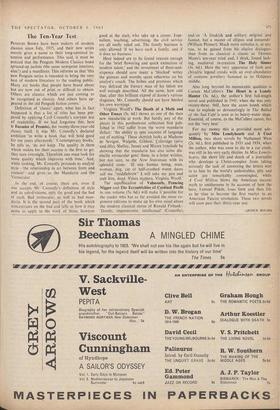The Ten-Year Test
PEW/um BOOKS have been makers of modern classics since July, 1935, and their new series merely gives a name to their long-admired in- tention and performance. This said, it must be noticed that the Penguin Modern Classics boast spruced-up jackets (the same newsprint interiors, alas!) and a manifesto. This informs us that 'this new Penguin series is intended to bring the very best of modern literature to the reading public. Many are books that people have heard about but are now out of print or difficult to obtain. Others are classics which are just coming to be recognised as classics. And others have ap- peared in the old Penguin fiction covers.'
Definition of 'classic' apart, what has in fact happened is that a list of titles has been pre-. pared by applying Cyril Connolly's ten-year test of readability. If we had forgotten this, here is Enemies of Promise, the twenty-three-year-old classic itself. It was Mr. Connolly's declared ambition 'to write a book that will hold good for ten years afterwards.' Contemporary books,' he tells us, 'do not keep. The quality in them which makes for their success is the first to go; they turn overnight. Therefore one must look for some quality which improves with time.' And, while looking, Mr. Connolly proceeds to analyse style---`the relationship in art between form and content'—and gives us the Mandarin and the Vernacular.
In the end, of course, there are, even if one accepts Mr. Connolly's definition of style and its sub-divisions, only the good and the bad of each Bad vernacular, as well as bad man- darin. It is the second part of the book which concentrates on the bad and tells us how it may come to apply to the work of those, however
good at the start, who take up a career. Jour- nalism, teaching, advertising, the civil service are all easily ruled out. The family business is only allowed 'if we have such a family, and if it does no business.'
Here indeed are to be found reasons enough for the 'brief flowering and quick extinction of modern talent,' and the investment of three-and- sixpence should save many a 'blocked' writer the guineas and months spent otherwise on his analyst's couch. The bribes and promises which may defraud the 'literary man of his talent are well enough described. All the same, how odd that, after this brilliant eXposé of doom's various disguises, Mr. Connolly should not have heeded his own warnings.
Virginia Woolf's The Death of a Moth and Other Essays (3s. 6d.) shows us one of the then ,
new mandarins at work. But hardly any of the pieces in this posthumous collection first pub- lished in• 1942 suffer from the worst mandarin defect: 'the ability to spin cocoons of language out of nothing.' These shortish looks at Madame de Sevign6, Walpole, 'Gibbon, Coleridge (pare and file), Shelley, James and Moore conclude by showing that the mandarin has also some dis- tinctly vernacular guts; these, in a letter written, but not sent, to the New Statesman with its splendid .coda: 'If any human being, man, woman, dog, cat or half-crushed worm dares call me "middlebrow" I will take my pen and stab him, dead. Yours etcetera, Virginia Woolf.'
The republication of Valmouth, Prancing Nigger and The Eccentricities of Cardinal Pirelli in one volume (5s. 6d.) will make it possible for the reader who has so far avoided the more ex- pensive editions to make up his own mind about the modern classical status of Ronald Firbank : 'Dandy, impressionist, intellectual' (Connolly),
and/or 'A freakish and solitary original and fantast, but a master of ellipsis and innuendo' (William Plomer). Much more stimulus is, at any rate, to be gained from his eluSive dialogues than from so classical a classic as Thomas Mann's ten-year tried and, I think, found lack- ing, mediaeval re-creation The Holy Sinner (3s. 6d.). Here the very apparatus of faith and chivalric legend creaks with an over-abundance of costume jewellery fastened to its CEdipean middle.
Also long beyond its memorable qualities is Carson McCullers's The Heart is a Lonely Hunter (3s. 6d.), the author's first full-length novel and published in 1941, when she was only twenty-three. Still, here the atom bomb which was to explode so devastatingly in The Ballad of the Sad Café is seen at its heavy-water stage. Essential, of course, to the McCullers canon, but not the 'very best.'
For my money this is provided most ade- quately ' by Miss Lonelyhearts and A Cool Million, two short novels by Nathanael West (2s. 6d.), first published in 1933 and 1934, when the author, who was soon to die in a car crash, was still in his very early thirties. In Miss Lonely- hearts, the short life and death of a journalist who develops a Christ-complex from taking seriously the task of answering the letters sent in to him by the world's undesirables, pity and satire are remarkably commingled, while A Cool Million blows the American success myth to smithereens in its account of how the hero, Lemuel Pitkin, loses limb and then life as he rises to become the first martyr in an American Fascist revolution. These two novels will soon pass their thirty-year test.
AR OB. R BOYARS














































 Previous page
Previous page